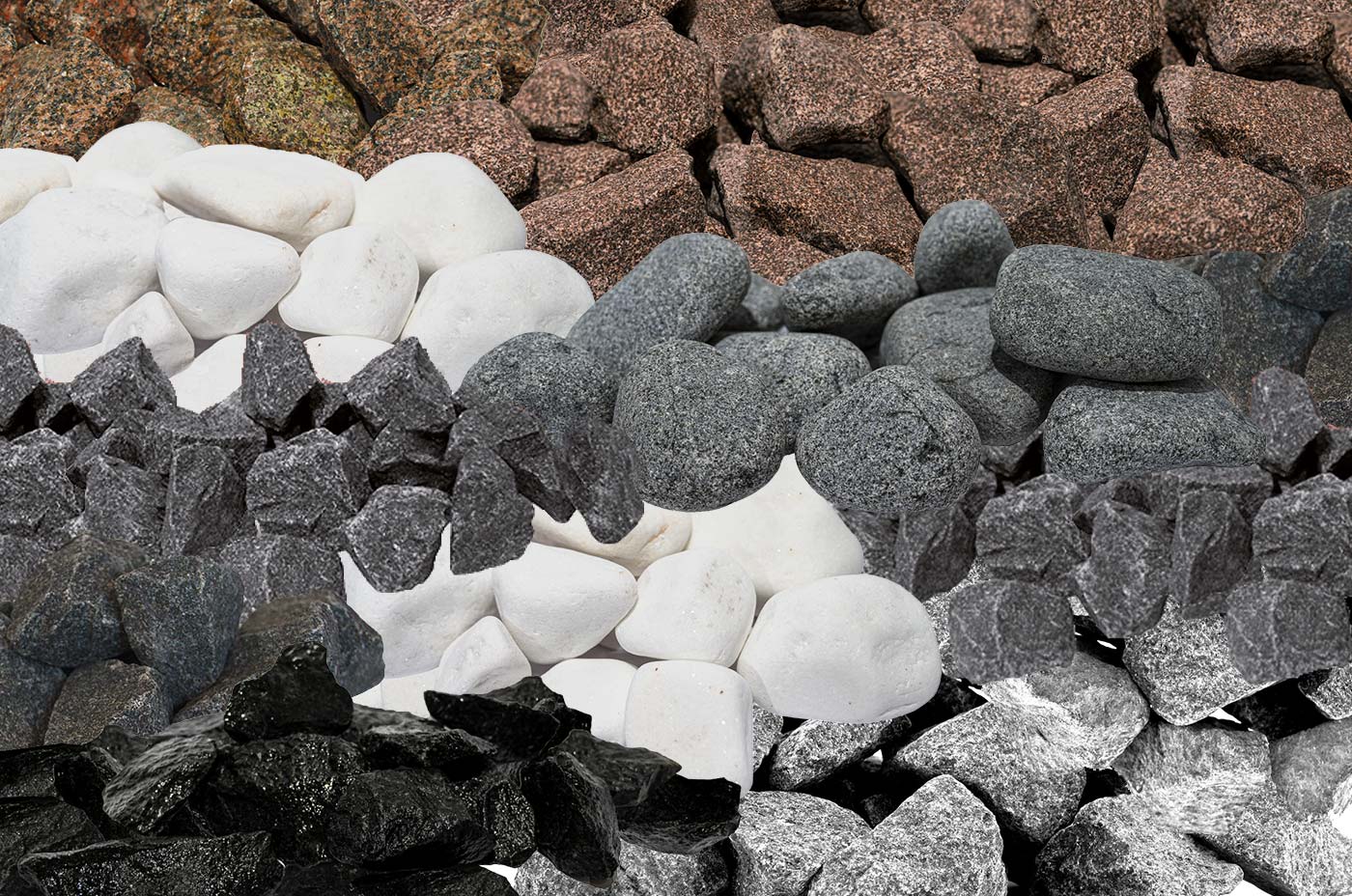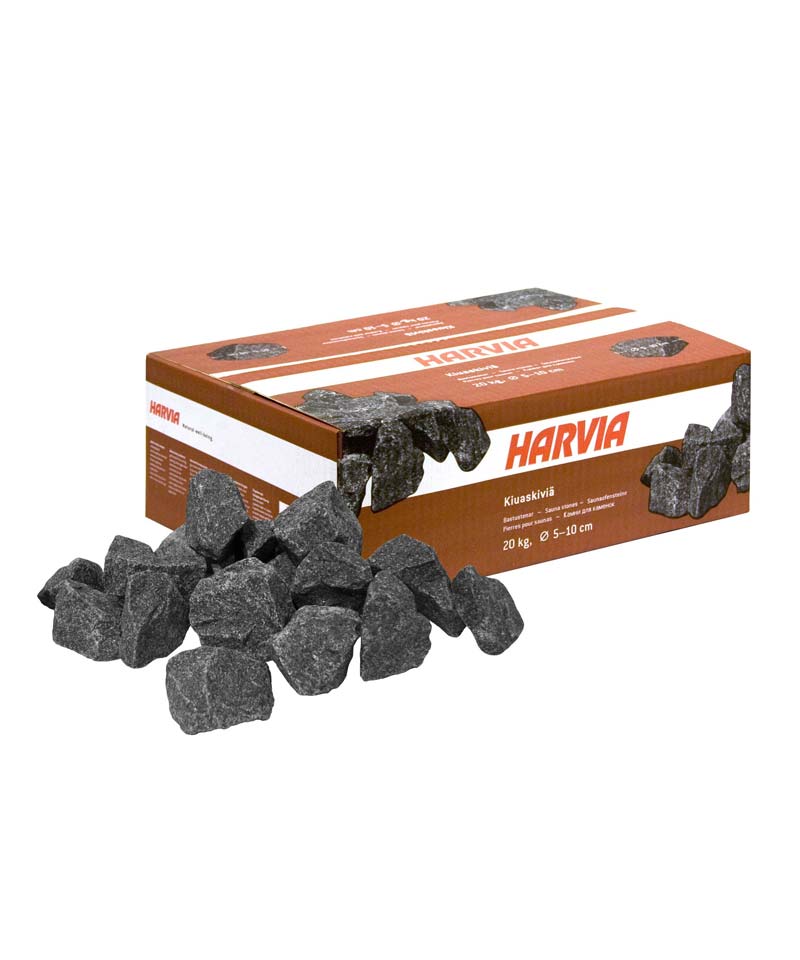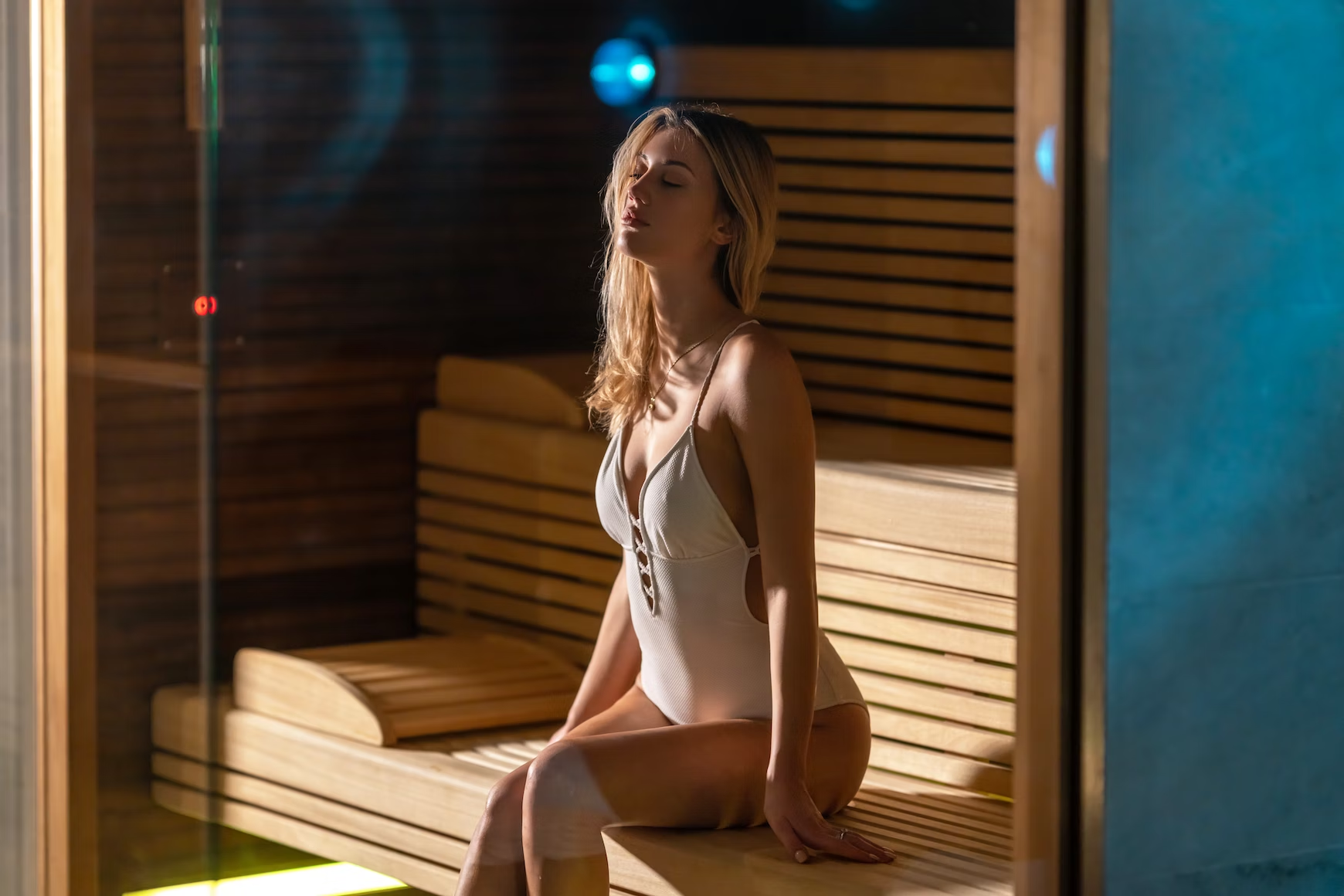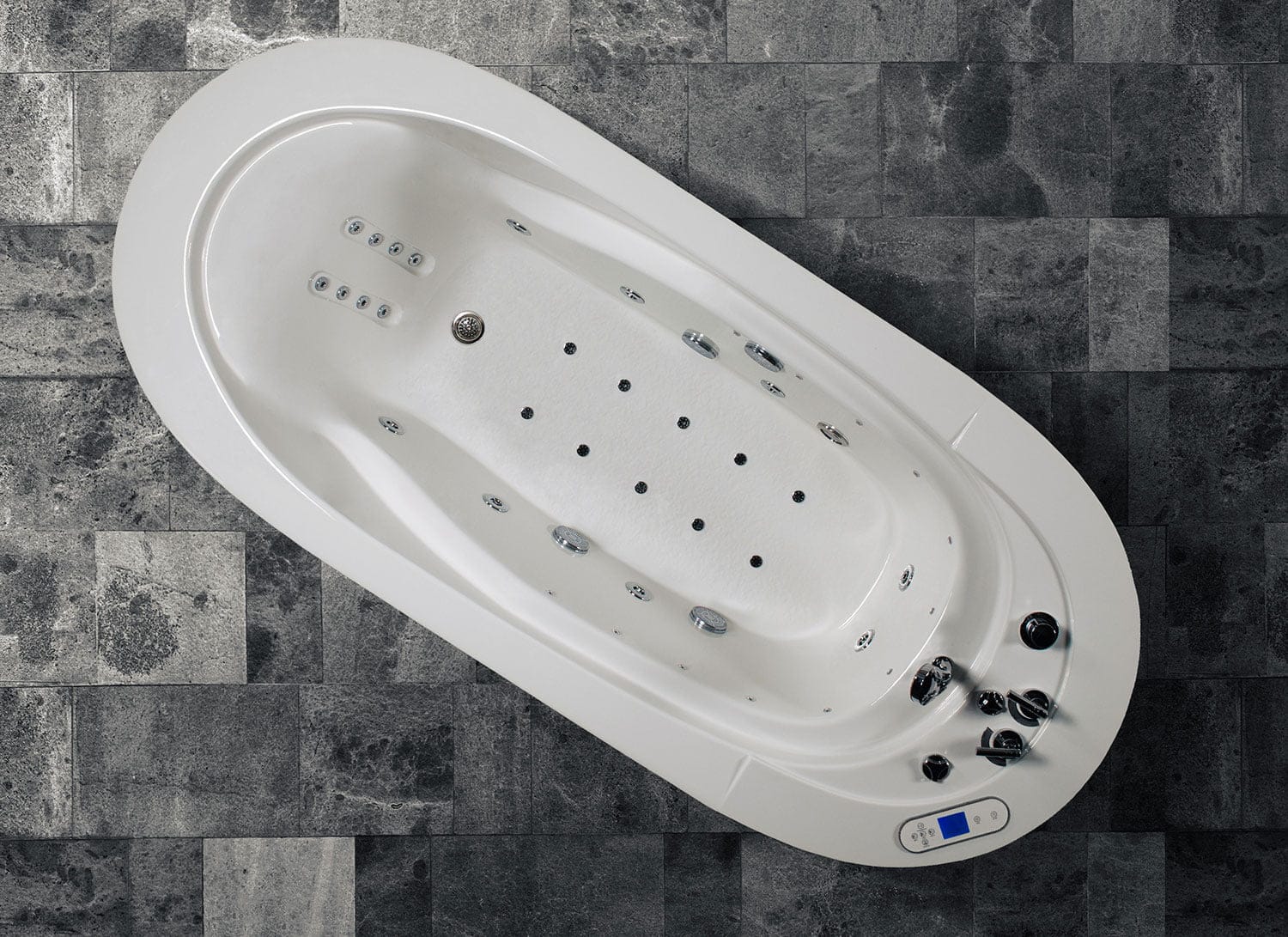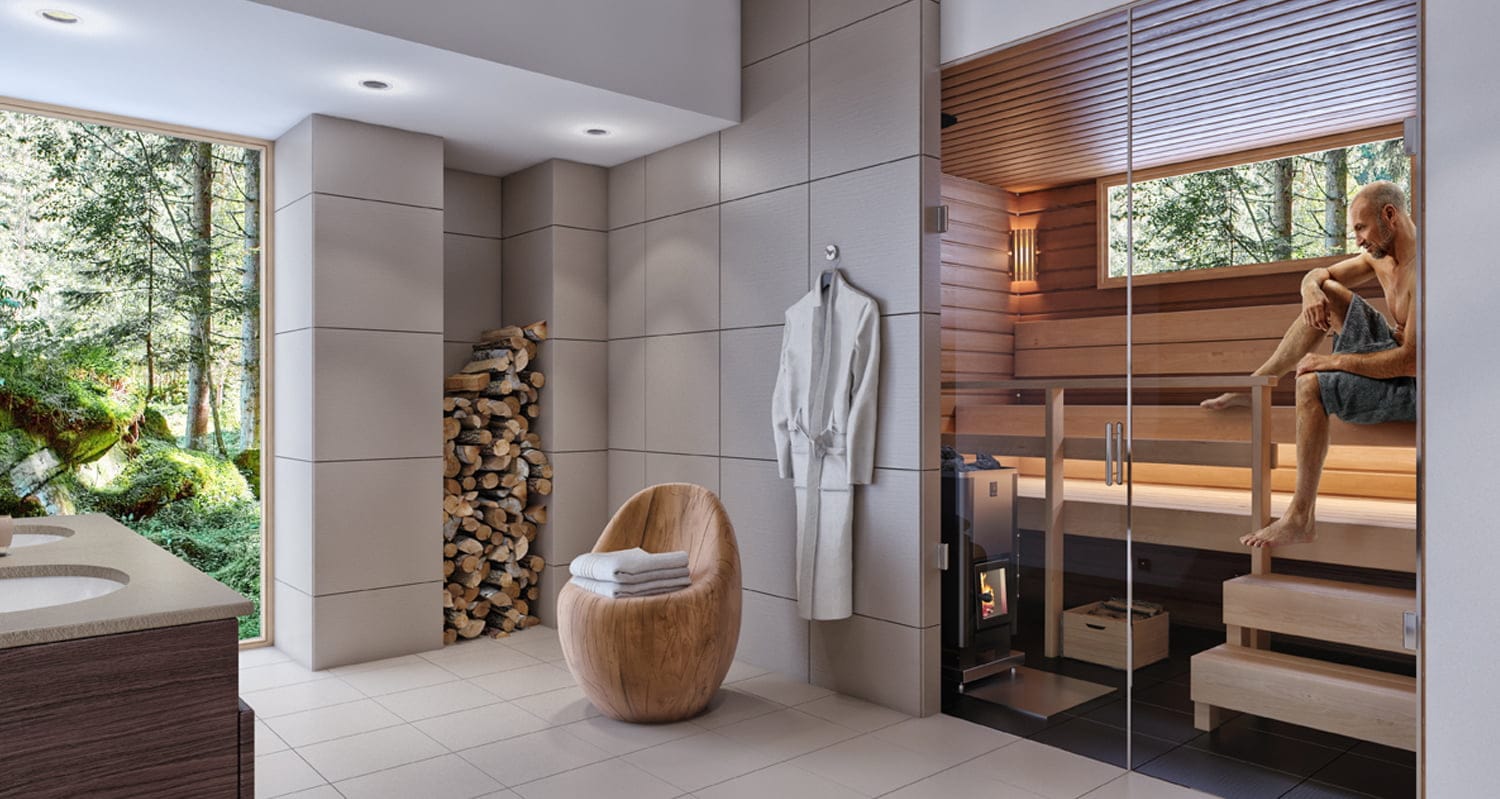Enter the tumultuous vortex of sauna enlightenment as we wrap our heads around 20 types of sauna stones and their unique heat retaining properties. In the mystical world of sauna culture, where the relentless pursuit of heat meets the mystique of ancient rock, we unravel the volcanic tapestry of stones that birthed the unique ambiance of sauna rituals.
From the gritty resilience of gabbro to the supposed healing properties of shungite, each stone tells a story steeped in the utility of heat retention and the spirit of cultural significance.
Join the wild ride as we navigate the twisted alleys of geological diversity, revealing the raw, unbridled secrets that forge the intoxicating blend of wellness and madness inherent in ancient sauna tradition. Whether you’re a seasoned acolyte or a curious neophyte, prepare for a mind-altering journey into the heart of sauna stone mysticism.
Table of contents
Origins of stone use in saunas
The use of stones in saunas dates back centuries, and the exact origins are not precisely documented. Saunas, as a concept, have ancient roots, and the use of heated stones evolved over time.
The tradition of sauna has deep historical roots, with early forms of saunas appearing in various cultures. The Finnish sauna, for example, is well-known and has a long history. The Finnish people have been using saunas for purification, relaxation, and health benefits for centuries. Early saunas were often simple structures, typically made from wood and featured a fireplace or stove. These early saunas used a variety of methods to generate heat, and stones were eventually incorporated into the design.
Stone use likely evolved as people sought ways to enhance the heating process. Stones were heated in the fire and then placed in the sauna to radiate heat and create the desired atmosphere. Over time, the practice of using specific types of stones, such as basalt, became more refined.
Over time sauna heaters or stoves were developed to hold and heat the stones. This allowed for better control of the temperature and steam generation. In 2015 archaeologists uncovered a bronze age building on the Orkney Islands believed to date from 4000BC – 10000BC. It is believed the building was an early sauna house.
Typical properties of sauna stones
Sauna stones, crucial to heat and steam generation, exhibit key properties essential for an optimal sauna experience and the generation of löyly. Their primary function lies in efficient heat retention that is released uniformly during your session. If they can get this right, the visual appearance of the stones becomes a matter of personal preference.
Typically, stones chosen for saunas must endure repeated heating and cooling cycles. Consequently, they need a repeatedly high degree of durability. Even heat distribution is paramount, ensuring consistent temperatures throughout the sauna. Resistance to thermal shock is vital for stones in direct contact with hot stoves.
Certain stones, like volcanic rocks, possess a porous nature, absorbing water to create steam. Non-reactivity to water is crucial, preventing the release of harmful substances during heating. Aesthetics contribute to the overall ambiance, with visually appealing colours and textures enhancing the sauna experience.
Local availability may also influence stone choices. Notably, cultural traditions play an important role in choosing sauna stones. The ideal sauna stones seamlessly combine these properties for an effective and enjoyable sauna atmosphere.
Local choices of sauna stones around the world
Sauna stones are sourced from various countries worldwide. Availability is inherently tied to the geological characteristics of each region. For example; in Finland, cultural traditions align with the use of stones like basalt, gabbro, and peridotite. Russia, with its diverse geological landscape, commonly employs stones such as gabbro, diabase, and shungite in its saunas, known as banyas.
Nordic countries, including Sweden and Norway, often utilise locally sourced granite and gabbro. In Iceland, volcanic stones like basalt are prevalent due to the country’s volcanic activity. Brazil favours specific types of durable granite for its saunas, while India appreciates the heat-retaining properties of soapstone.
South Africa, too, may incorporate igneous rocks like diabase into sauna heating. Selection of sauna stones is generally influenced by both local geological features and cultural preferences, creating a diverse array of options worldwide.
Our top 3 picks of the best sauna stones
- Olivine diabase: Known for its high density and excellent heat retention, olivine diabase can efficiently store and radiate heat in the sauna, creating a comfortable and consistent temperature.
- Red granite: Red granite is valued for its aesthetic appeal and durability. Furthermore, it contributes to a sauna’s heat retention and distribution, enhancing the overall sauna experience.
- Gabbro: Gabbro is a reliable choice for sauna stones due to its durability and ability to withstand high temperatures. It helps maintain a consistent heat level in the sauna, ensuring a comfortable and effective sauna session.
Here’s our list of 20 types of sauna stones
Before you begin it’s important to understand that they are not listed in any particular order. That said, diabase and granite are the most popular types of sauna stones for their all round heat retaining capabilities, availability, aesthetics and durability. This is true for use in both domestic and commercial saunas.
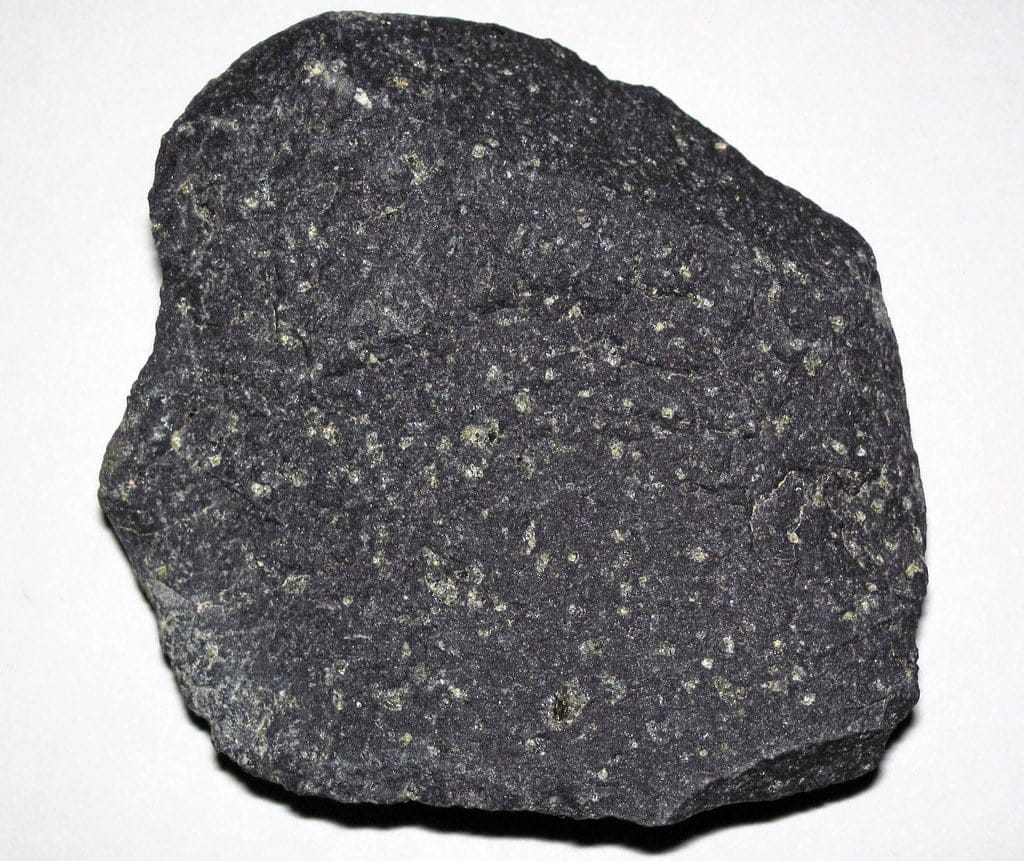
Olivine basalt stones, volcanic in nature, can withstand the high temperature demands of a sauna without cracking or breaking.
1. Basalt: Dark and volcanic
Originating from volcanic rock, certain types of basalt stones are favoured in saunas for their superior heat retention and distribution. Found globally in regions with volcanic activity, these dark-hued stones, typically black or dark gray, absorb and store heat effectively.
Heated by electric sauna heaters and wood burning stoves, they release stored heat, ensuring a consistent and comfortable sauna temperature. Renowned for durability, basalt stones withstand high sauna temperatures without cracking. Their smooth, slightly porous texture provides a comfortable surface, contributing to the diffusion of steam when water is poured over them.
Notably, basalt stones hold cultural and therapeutic significance, often associated with practices like hot stone massages. Widely available, basalt’s prevalence globally cements its popularity in sauna construction for an enhanced and culturally rooted sauna experience.
Olivine basalt, also known as olivine tholeiite, is a type of basaltic rock that contains the mineral olivine. It is a volcanic rock that forms from the cooling and solidification of lava. Olivine basalt shares many characteristics with traditional basalt, including its durability and heat-retaining properties.
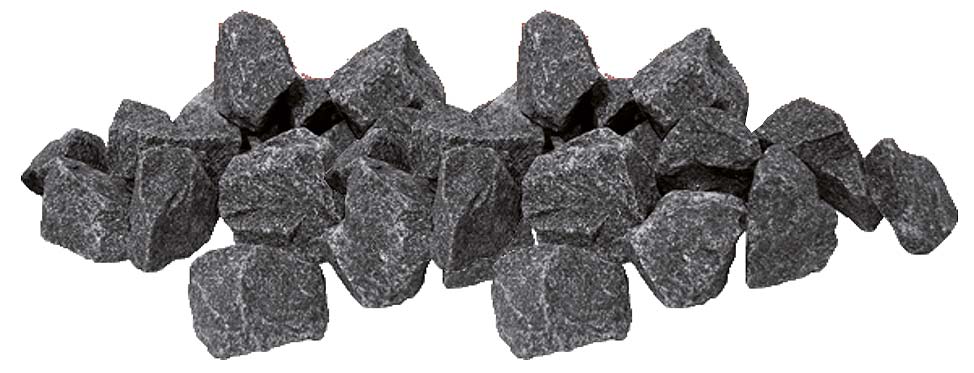
Remarkably resilient, Olivine Diabase is a common igneous rock used for heating saunas.
2. Diabase: Globally popular
Diabase stones, also known as dolerite, are a type of igneous rock that forms from the slow cooling of molten lava. This rock is typically dark gray to black in colour and has a medium to coarse-grained texture. Diabase is composed mainly of plagioclase feldspar, pyroxene, and sometimes olivine.
One of the distinctive features of diabase is its durability and resistance to weathering. This has led to its use in construction as well as for sauna stones. Due to its fine-grained nature, diabase can exhibit excellent strength and is often used for monuments, and building facades.
Diabase stones, and more commonly olivine diabase stones are globally used in saunas. Similar to other igneous rocks like basalt and gabbro, diabase has the ability to withstand high temperatures. The stones offer excellent heat retention and substantial steam generation when water is ladled onto them during sauna sessions.
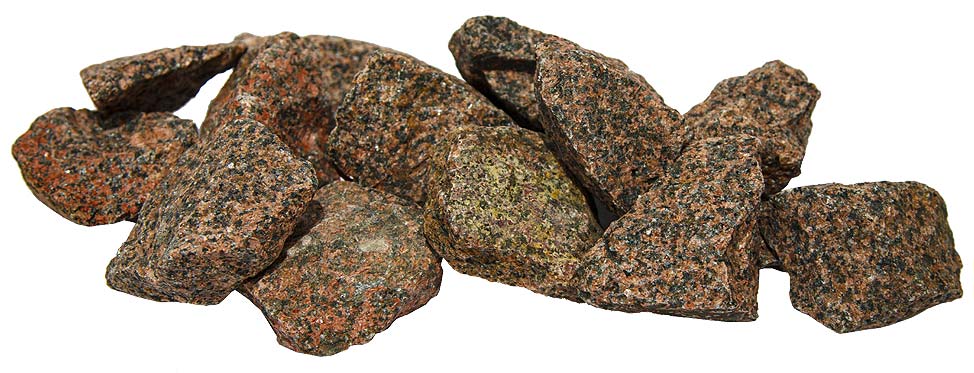
Red granite is a popular choice in saunas for its heat retaining and aesthetic properties.
3. Granite: Timeless elegance
Granite is a much sought-after material for sauna stones. It is valued for its durability, exceptional heat-retaining properties, and aesthetic versatility. Composed of minerals like quartz, feldspar, and mica, granite exhibits a serious level of robustness. Consequently, it can easily withstand the rigorous heating and cooling cycles in saunas without succumbing to breakage.
Its ability to retain heat ensures a consistent and comfortable sauna temperature. As a result it is a popular choice for löyly seekers. Additionally, granite comes in a spectrum of colours, including shades of gray, pink, red, black, and brown. This has made it the go to choice for sauna designers the world over.
The visual appeal of granite sauna stones enhances the overall ambiance. Different varieties are chosen based on regional availability and cultural preferences. In Nordic countries, for instance, ‘Nordic Red’ granite is a hugely popular choice. This reflects both aesthetic considerations and a connection to local traditions in sauna construction.
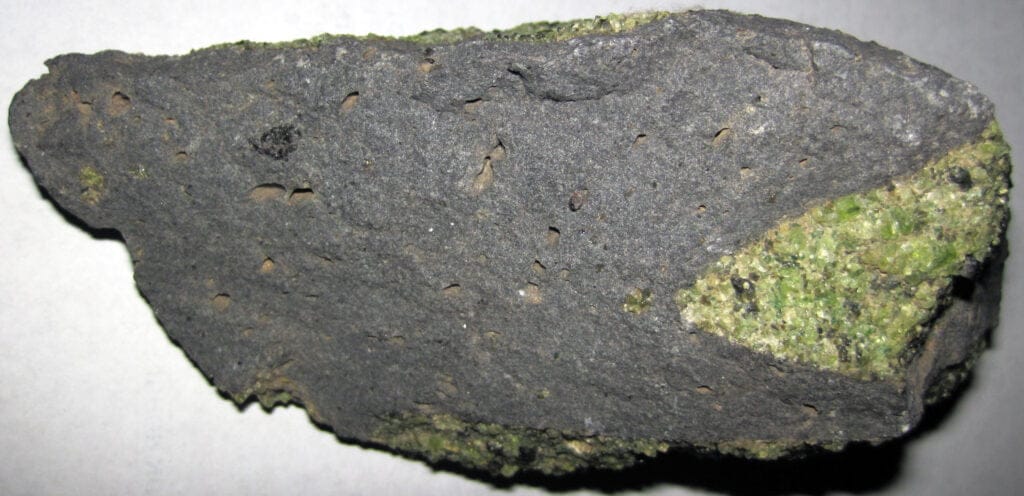
Composed largely of olivine and pyroxene, peridotite has sufficient properties for use as a sauna stone.
4. Peridotite: Heat resistant elegance
Peridotite is used for sauna stones due to its unique heat resistant and retaining properties. This igneous rock, composed largely of olivine, pyroxene, and other minerals, is known for its high density and ability to withstand extreme temperatures. Peridotite’s exceptional heat resistance is what makes it a suitable stone for use in sauna stoves or heaters.
It can endure intense thermal conditions without compromising its structural integrity. While it is not the most popular sauna stone, peridotite still delivers a consistent heat and even sauna experience. The distinctive greenish hue of peridotite adds an aesthetic element to sauna.
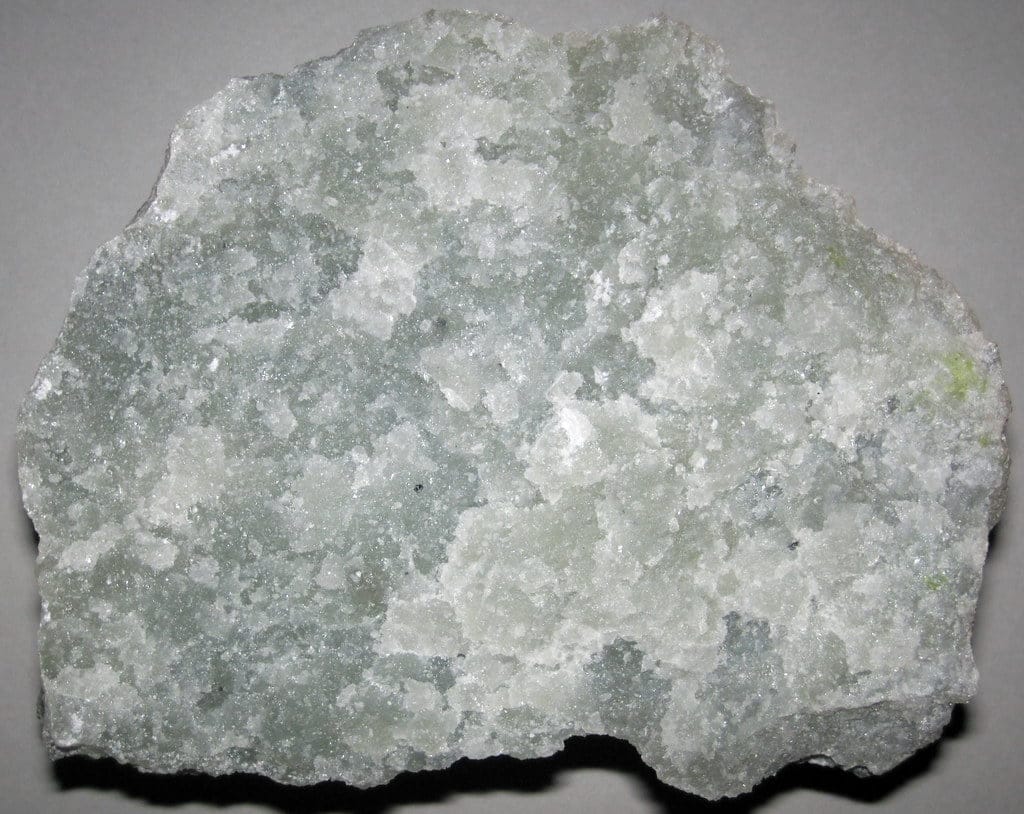
Not widely used for sauna stones, soapstone is still regarded for its remarkable heat retention capabilities.
5. Soapstone: Slow and steady heat
Soapstone is a reliable choice for sauna stones owing to its remarkable heat retention capabilities. Composed primarily of talc, chlorite, pyroxenes, amphiboles, carbonates, and other minerals, soapstone is also used to manufacture aromatherapy bowls for sauna heaters. The natural heat retention properties make it an ideal material for use in saunas. It will release a consistent and lingering warmth, contributing to a prolonged and enjoyable sauna.
Additionally, soapstone has a resistance to cracking or breaking under high temperatures. This further enhances its popularity in sauna environments. The gray, green, or black hues of soapstone provide a visually pleasing option for anyone seeking both functionality and style in their sauna stones.
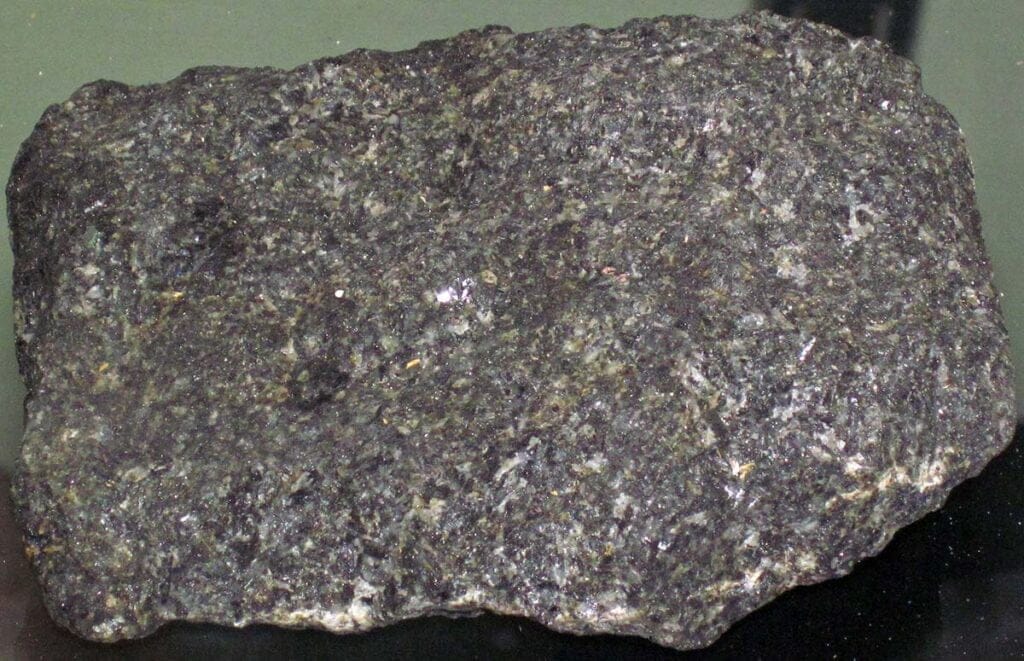
Gabbro is often chosen for cultural reasons and a connection to the landscape.
6. Gabbro: Dark and durable
Gabbro is a preferred choice for sauna stones due to its excellent heat-retaining properties and durability. This intrusive igneous rock, composed mainly of plagioclase feldspar, pyroxene, and sometimes olivine, has a high resistance to both high temperatures and thermal shock.
Gabbro sauna stones efficiently absorb and store heat, distributing it evenly throughout the sauna. The stones withstand the repeated stress of heating and cooling in saunas without succumbing to cracks or breaks. Gabbro’s dark colour, typically black or dark green, adds to its aesthetic appeal.
One unique aspect of gabbro’s use for sauna stones is its connection to cultural traditions, particularly in Nordic countries. In these regions, gabbro is often chosen not only for its practical properties, but also for its cultural significance. The use of locally sourced gabbro stones aligns with the tradition of incorporating natural elements from the surrounding environment into sauna construction.
This practice not only reflects a practical choice based on the rock’s geological properties but also deepens the cultural and historical roots of the sauna experience. Gabbro, in this context, is much more than just a sauna stone. It is a symbol of the connection between the sauna, the natural landscape, and the cultural heritage of the region.
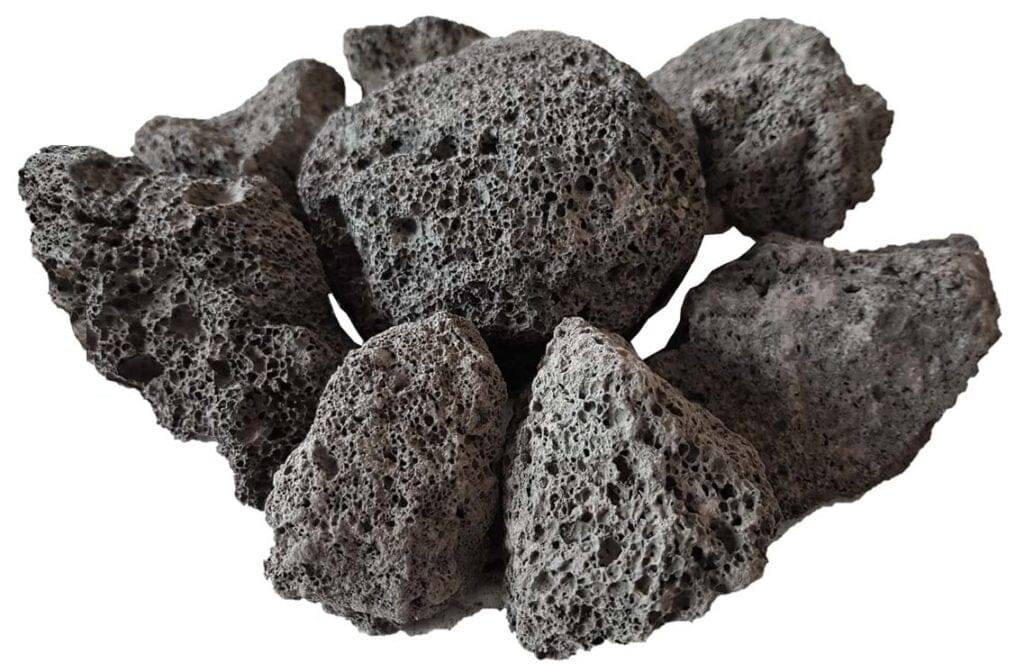
Solidified lava, porous in nature, has efficient heat absorbing properties making it ideal for sauna stones.
7. Lava: Dark and porous
Lava stones are a distinctive and practical choice due to their unique volcanic properties. Derived from solidified lava, these stones are known for their porous nature, allowing them to efficiently absorb and radiate heat. Lava stones excel in creating a gentle and moist heat in saunas. When water is ladled over heated lava stones they generate huge plumes of steam.
The porous texture of lava stones results in excellent diffusion of steam, providing bathers with a soothing and enveloping sensation. What’s more, the use of lava stones in saunas adds an aesthetic dimension. The characteristic black or dark gray colours, coupled with the fascinating history of volcanic origins contributes to the aesthetics and ambiance of the ritual.
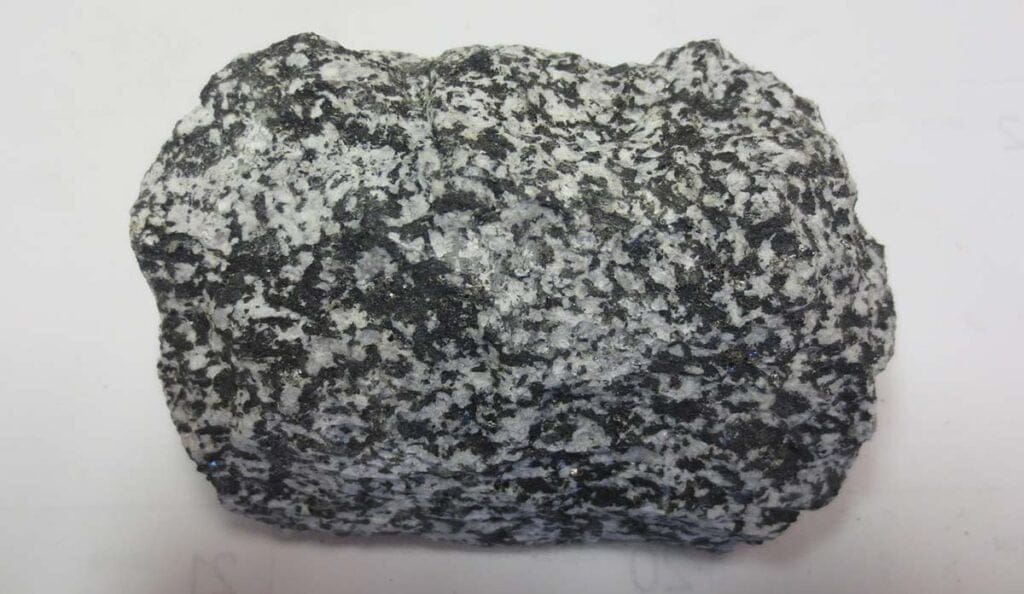
Occasionally chosen for sauna stones, Diorite can withstand high temperatures and thermal shock.
8. Diorite: Hard and resilient
Diorite is an intrusive igneous rock composed of plagioclase feldspar, biotite, hornblende, and sometimes quartz. It is occasionally chosen for sauna stones due to its durable nature and resistance to weathering. In sauna applications, stones need to withstand high temperatures and thermal shock, and diorite exhibits commendable resilience under such conditions.
While not as commonly used as some other stones, diorite still has the ability to endure the stress of heating and cooling in saunas. Consequently, it a suitable option for sauna stoves or heaters. Its gray to black appearance offers a certain aesthetic appeal, making it somewhat attractive as a sauna stone.
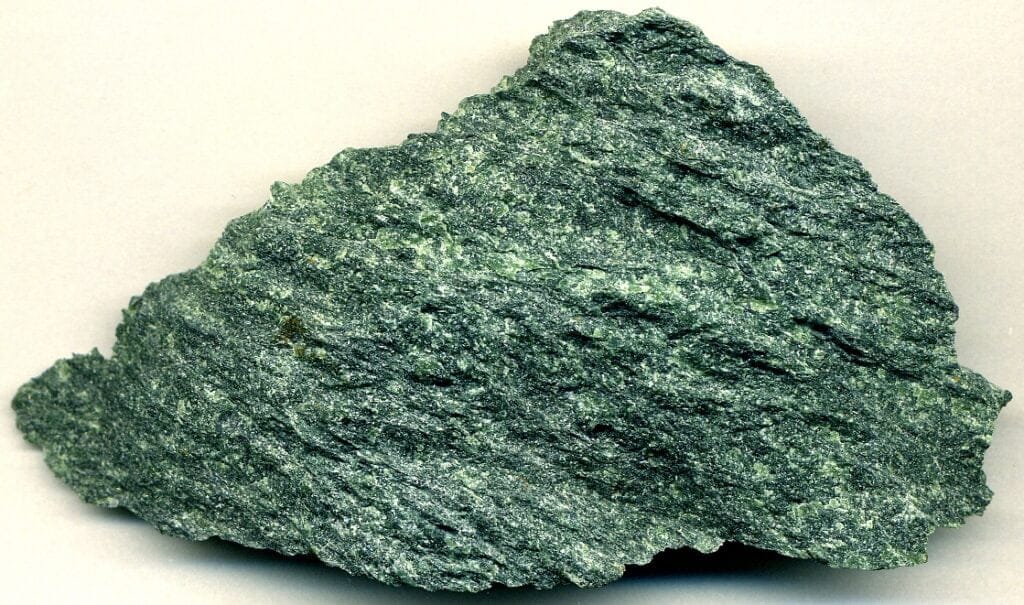
Serpentine is often chosen for holistic reasons as much as general stone suitability.
9. Serpentine: A touch of green
Characterised by its greenish hues and wavy patterns, Serpetine, a metamorphic rock is occasionally chosen for use as sauna stones due. While not in common use, serpentine is nevertheless valued for its resistance to heat and durability.
Serpentine’s ability to withstand rapid temperature changes makes it a suitable choice for use in sauna stoves or heaters. The distinctive green colour adds an aesthetic element and it is sometimes mixed with other coloured rocks in the sauna heater. Cultural preferences and regional availability influence the use of serpentine as a sauna stone.
Uniquely, serpentine use in saunas has some association with holistic and metaphysical beliefs. In some cultural contexts, serpentine is believed to possess healing properties and is associated with promoting relaxation and a sense of well-being.
As a result, some people may choose serpentine sauna stones not only for their durability and heat-retaining properties, but also with the belief that the stone contributes to a more therapeutic sauna experience.
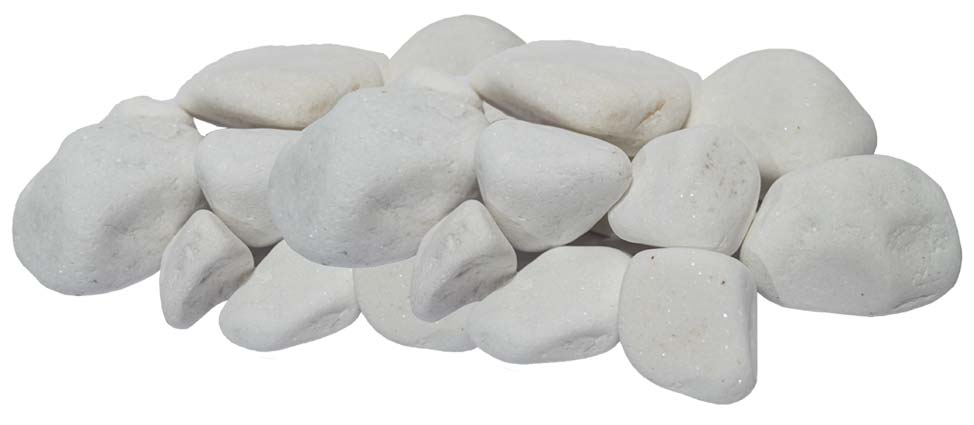
White marble is often used as a final layer of stones for aesthetic reasons.
10. Marble: Smooth and luxurious
While marble is not as prevalent as igneous rocks in sauna use, its occasional use is often driven by aesthetic considerations. Marble, a metamorphic rock derived from limestone, is appreciated for its luxurious appearance, unique veining patterns, and a variety of colours. These colours can range from whites and creams to pinks, greens, and grays.
Saunas featuring marble stones are often elegant and visually distinctive. The use of marble as sauna stones is more common in settings where the emphasis is on creating a spa-like or upscale environment. However, it’s important to note that marble may not possess the same heat retention properties as some other stones traditionally used in saunas.
Consequently, marble sauna stones are often used as a decorative layer on top of standard olivine diabase stones. Specific types of marble, such as Carrara marble, Calacatta marble, or Verde Alpi marble, may be chosen based on their colour, veining, and availability.
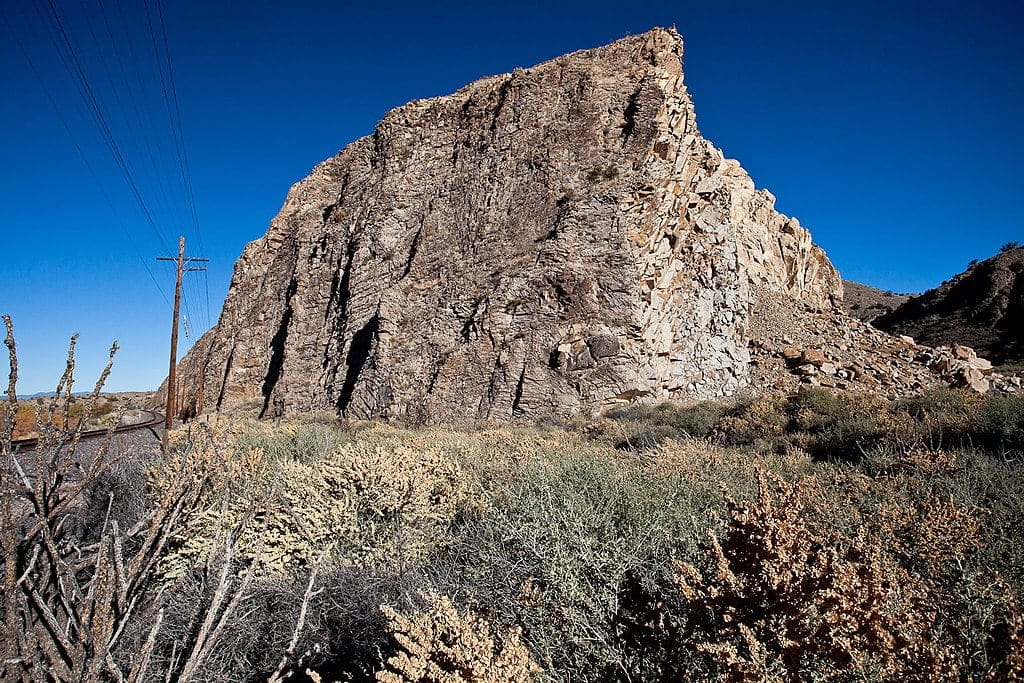
Devil’s Throne, a sill of andesite porphyry in the Cerrillos Hills of New Mexico. Greg Willis from Denver, CO, usa, CC BY-SA 2.0, via Wikimedia Commons
11. Andesite: Fine grained and dark
With fine-grained texture and typically gray to black colour, Andesite, an igneous rock is also sometimes used as a stone for heating saunas. Able to withstand high temperatures and effectively retain heat, Andesite is commonly found in volcanic regions around the globe.
Geographically, regions with notable occurrences of andesite include the Andes Mountains in South America, the Cascades Range in the United States, the Japan Arc, and various volcanic islands around the Pacific Ring of Fire. Andesite’s exhibits decent heat-retaining properties, and its practicality, combined with regional availability, makes it a suitable choice for sauna stones in certain areas.
Andesite is a product of intermediate volcanic activity. It forms from the cooling and solidification of magma with intermediate silica content in subduction zones, where tectonic plates converge. Notably, the Devil’s Throne in New Mexico is an Andesite rock.
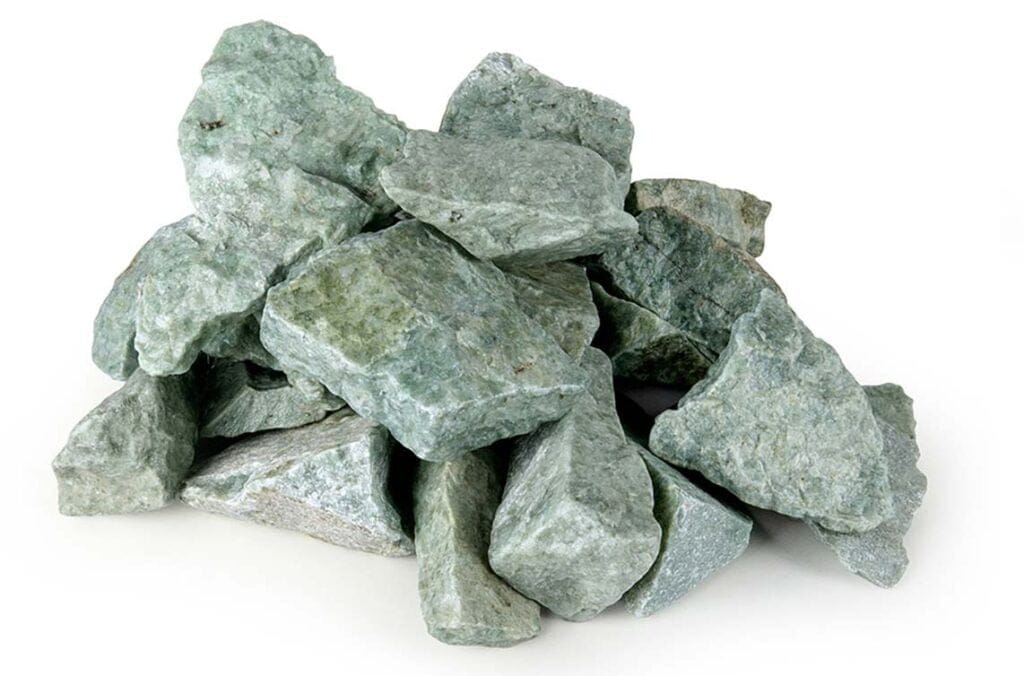
Nephrite or Serpentine jade stone is sometimes incorrectly referred to as jadeite when sold as sauna stones.
12. Jadeite: Green and mystical
There’s an important distinction to be made here. Jadeite itself is not a typical choice for sauna stones due to its rarity, high value and unique properties. Other jade stones with similar names are often used as sauna stones.
Nephrite jade, distinct from jadeite, and is commonly used in traditional saunas. Nephrite jade is a tough and durable stone that can withstand high temperatures, making it more than suitable for sauna heaters. Additionally, serpentine jade, a metamorphic rock also exhibits properties suitable for sauna stones.
It’s crucial to differentiate between jadeite and other stones with similar names. Jadeite itself is not typically chosen for sauna environments. Notably, the purported benefits of using jadeite stones in the practice of lithotherapy, which is a pseudoscientific alternative medicine practice has been unproven. Websites claiming healing powers of jadeite stones in saunas should be avoided.

Shale use in saunas is influenced by factors such as local availability, aesthetics and cost.
13. Shale: Fine and grainy
Shale is classified as a sedimentary rock. It is characterised by its fine-grained clay composition, and is occasionally used as a sauna stone depending on geography. Its selection is influenced by local availability, aesthetic considerations and cost-effectiveness. In regions where shale is abundant, it can be a practical and economical choice for sauna stones.
The layered or fissile structure of shale gives it its natural and earthy aesthetic. Consequently, it can appeal to individuals looking for a particular sauna aesthetic. While shale may not possess the same heat retention properties as igneous rocks, it can still serve the purpose of providing a surface for water to be poured over. The effectiveness of localised shale stone can be assessed on its mineral composition and structural characteristics.
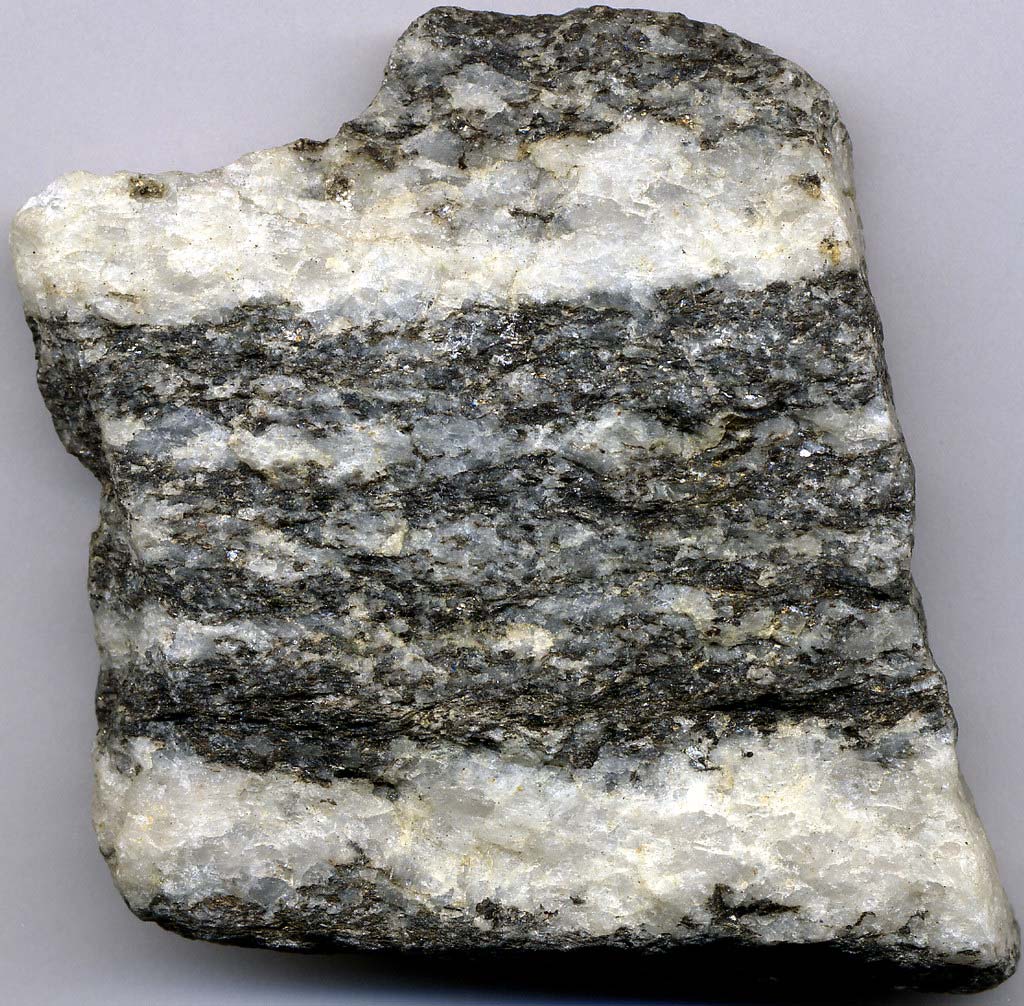
Gneiss is a metamorphic rock with characteristic bands resulting from an arrangement of mineral grains.
14. Gneiss: Grainy and banded
Not as widely used as igneous rocks, gneiss does get used as a sauna stone. Decisions to include gneiss as a sauna stone usually centre around local availability, aesthetic preferences and regional traditions. The visual appeal of gneiss, characterised by its banded appearance, offers a distinctive and captivating element to the sauna ambiance.
In areas where gneiss is abundant, its use becomes a practical and environmentally conscious choice. Through this it aligns with cost-effective measures to use locally sourced materials. Although gneiss may not possess the heat retention properties of popular igneous rocks common in saunas, its thermal characteristics can still contribute to a warm and comfortable sauna environment.
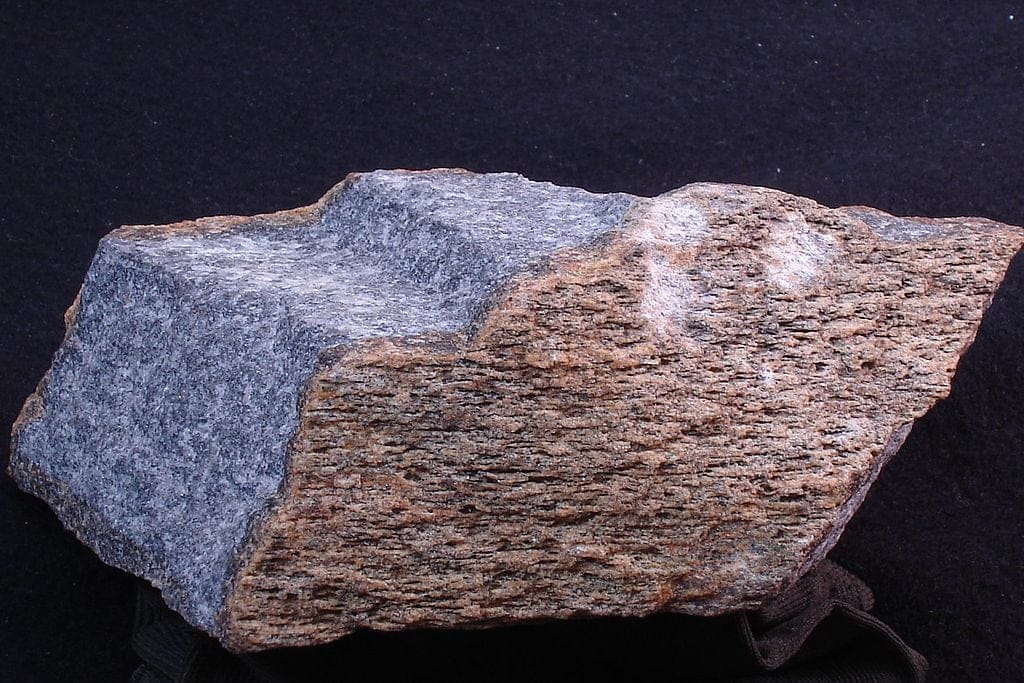
Medium grained granulite of metasedimentary origin. CC BY-SA 3.0, via Wikimedia Commons
15. Granulite: High grade, high temperature
Granulite, being a high-grade metamorphic rock, can withstand high temperatures, a crucial factor in sauna stones. It typically forms under high-temperature and high-pressure conditions, and is composed mainly of minerals such as quartz, feldspar, garnet and importantly olivine.
While granulite is not commonly used sauna stones, it does have certain characteristics that may make it suitable for specific sauna applications. This combined with regional availability mean that granulite does get used as a stone for heating saunas, but only in certain regions. If it is locally abundant, it is a practical choice for sauna stones.
Granulite can display a range of colours, including gray, greenish-gray, and pink, depending on its mineral composition. If considering granulite for sauna use, it’s advisable to consult with an expert to ensure that the chosen stones meet the necessary requirements for effective and safe sauna operation.
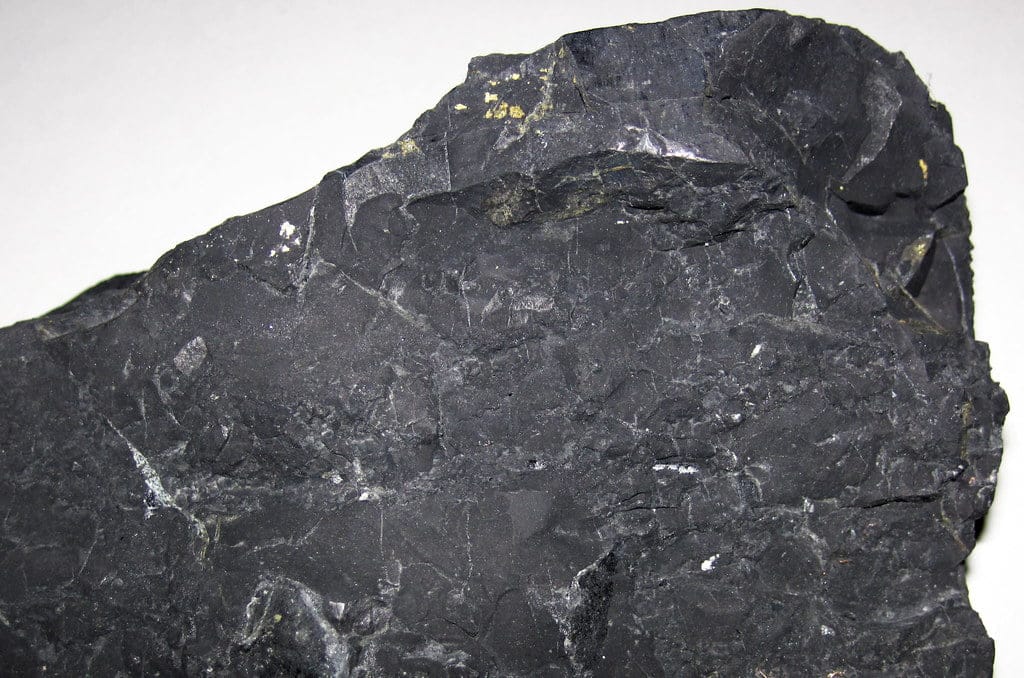
Shungite stone use in saunas is believed by some enthusiasts to provide health benefits. The rocks typically exhibit antimicrobial and antioxidant properties.
16. Shungite: Dark and mysterious
Shungite is primarily found in certain regions of Russia, particularly in the Karelia region. Dark in colour, it is a unique and distinctive carbon-rich mineral that has gained popularity for its purported health and water-purifying properties. Whilst not commonly used as sauna stones, some enthusiasts have explored the use of shungite in saunas.
Notably, shungite is believed by some to have various health benefits, including antimicrobial and antioxidant properties. In some regions shungite has been in saunas for its potential positive effects on well-being.
Shungite’s unique properties, including its ability to retain heat, high carbon content, and fullerenes, contribute to its distinctive characteristics.
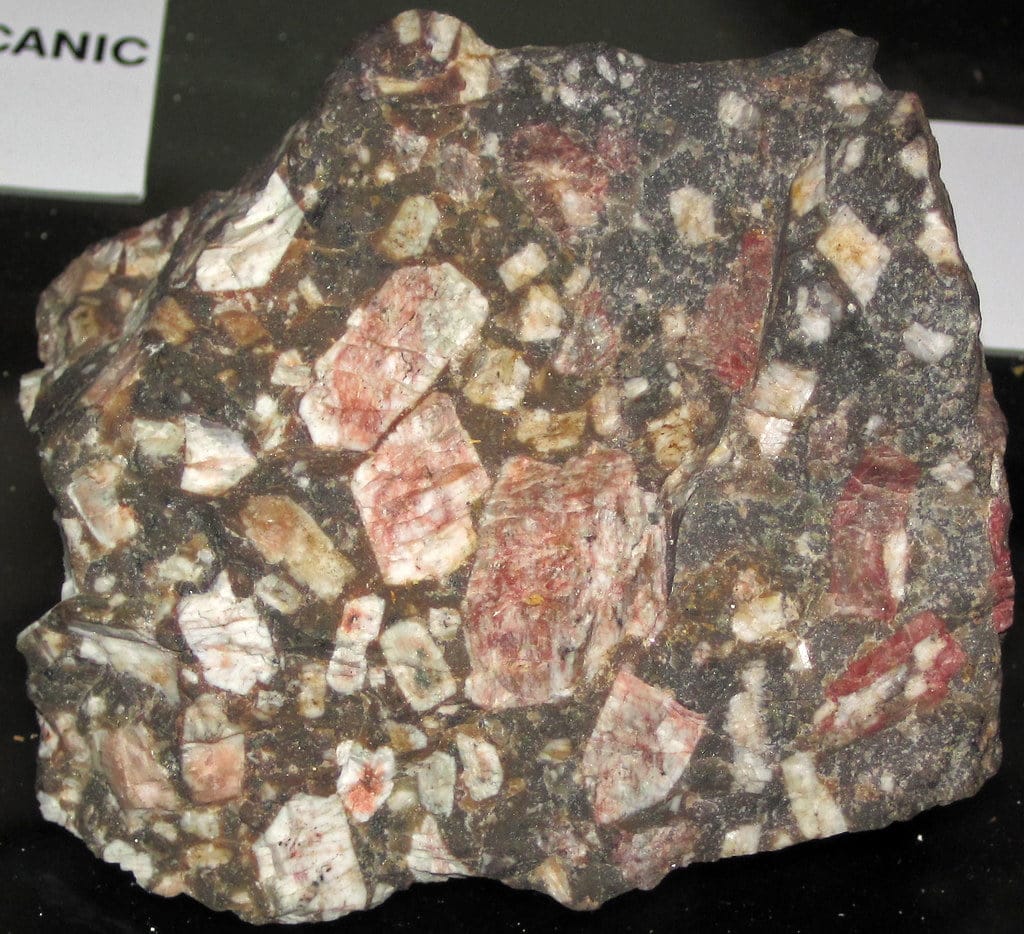
Though not widely used, Trachyte is a volcanic rock, and possesses heat-retaining properties and the durability required for effective sauna heating.
17. Trachyte: Brown and speckled
As a volcanic rock, Trachyte does have some heat-retaining properties. However, its use as a sauna heating stone depends on specific mineral composition, thermal conductivity, and resistance to cracking or breaking under extreme heat.
While trachyte does possess some of the desired characteristics for sauna use, it’s not as widely used for this purpose. The use of Trachyte is confined to geography where more common stones such as olivine diabase or gabbro are not available.
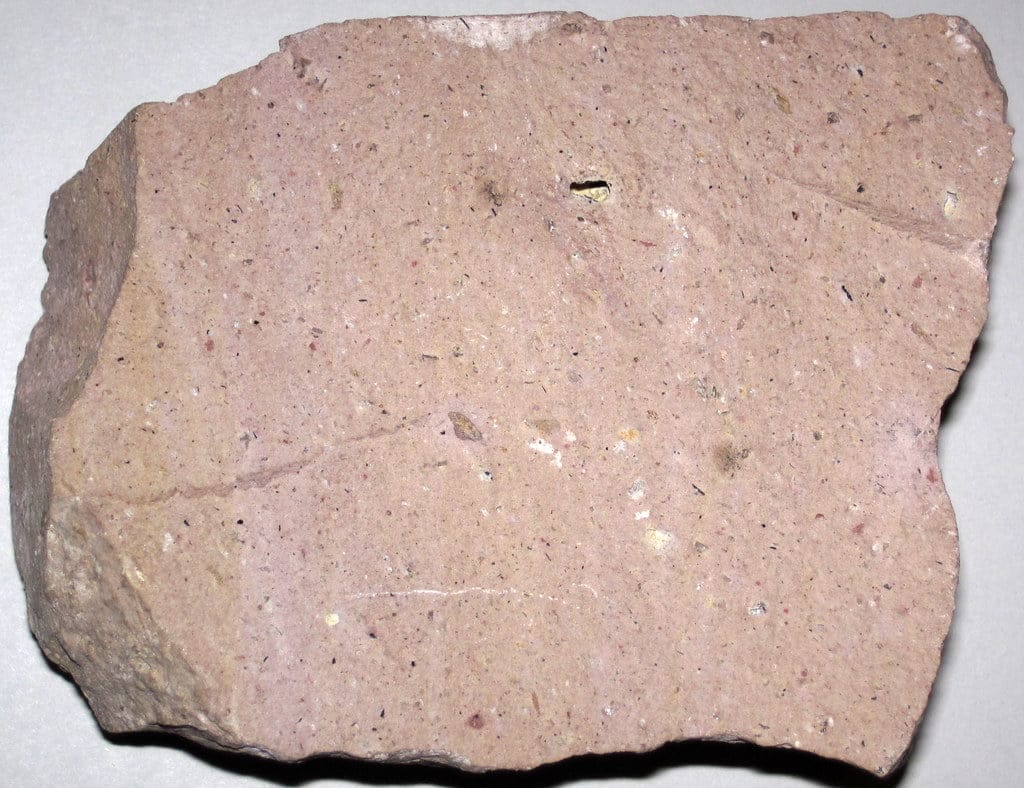
Rhyolite, like many volcanic rocks, has the potential to retain heat making it a candidate for sauna stone use.
18. Rhyolite: Pink and volcanic
Another volcanic rock (you can see there’s a theme here), rhyolite is characterised by its silica-rich composition. It is often smooth and light-coloured in appearance, ranging from gray to pink or brown. Found in various volcanic regions worldwide, it is associated with both explosive eruptions producing ash and pyroclastic flows, as well as effusive eruptions resulting in lava flows.
Notably, rhyolite can retain heat and doesn’t crack under high temperatures, a crucial property for sauna stones. However, it does exhibit heat-retaining capabilities, rhyolite is not as commonly used as other volcanic rocks like basalt or gabbro.
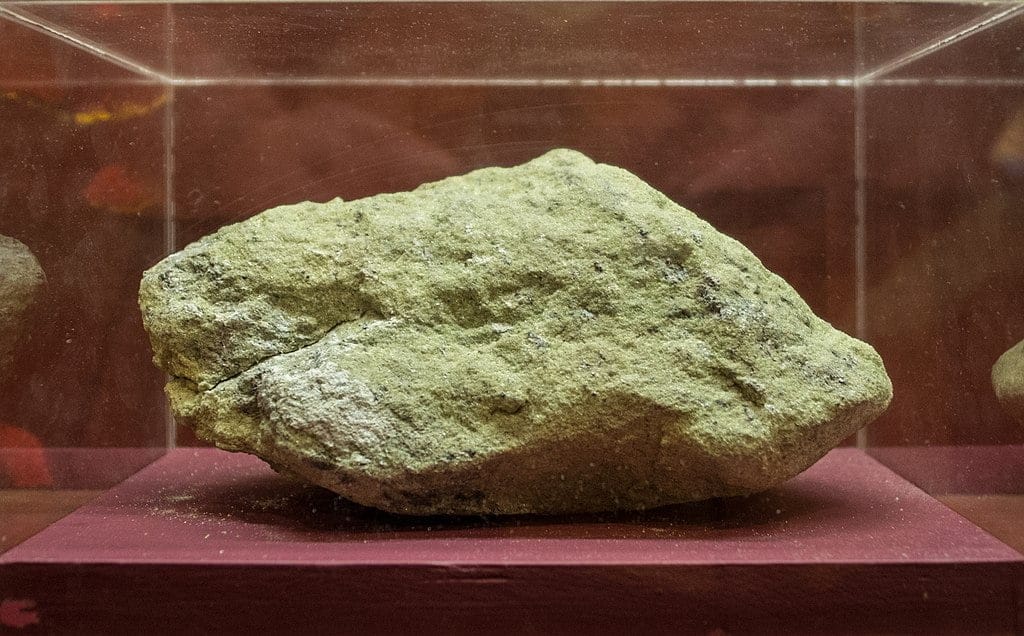
Dunite, an ultramafic rock is primarily composed of olivine which is found in many types of sauna stones. Tim Evanson from Cleveland Heights, Ohio, USA, CC BY-SA 2.0, via Wikimedia Commons
19. Dunite: Green and textured
Dunite is a type of ultramafic rock primarily composed of olivine, a green mineral rich in magnesium and iron. This rock is recognised for its unique properties and is often found in mantle peridotite formations. Its characteristic olive-green colour and high olivine content distinguish dunite from other rocks.
Dunite’s composition, particularly the presence of olivine, provides good heat-retaining capabilities. Olivine is known for its ability to absorb and radiate heat effectively. However, while dunite can be used as a sauna stone, it is not as commonly used outside of geographical availability.
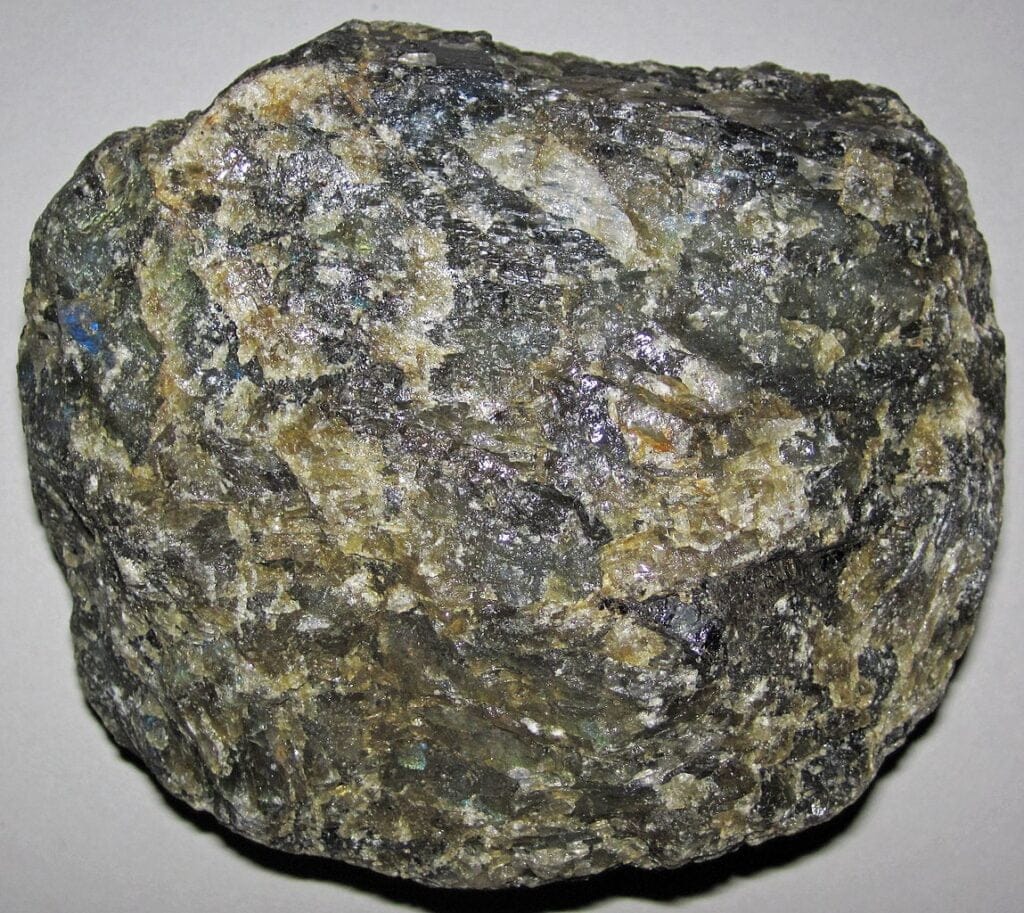
Coarse-grained and somewhat speckled, Anorthosite is a found in the Earth’s crust. James St. John, CC BY 2.0, via Wikimedia Commons
20. Anorthosite: Coarse and speckled
Finally, we have Anorthosite. This a coarse-grained igneous rock is primarily composed of plagioclase feldspar and is sometimes speckled in appearance. It is commonly found in the Earth’s crust and often associated with lunar rock compositions.
Anorthosite’s properties include a high abundance of plagioclase, which gives it a relatively low density when compared to other igneous rocks. Its composition exhibits some heat-retaining properties, however, it is not commonly used as a sauna stone outside of geographic locality.
Frequently asked questions
What are the benefits of sauna stones?
Sauna stones play a pivotal role in enhancing the sauna experience through steam generation and even heat distribution. The primary benefit lies in the creation of a soothing and therapeutic environment. Pouring water onto the heated stones produces steam, which not only raises humidity but also promotes relaxation and detoxification.
The gentle heat emitted by the stones helps open pores, improve circulation, and alleviate muscle tension. This in turn contributes to an overall sense of well-being and rejuvenation.
What kind of stones do you use in a sauna?
Various types of stones are employed in saunas, each chosen for specific qualities. Common choices include basalt, gabbro, granite, and volcanic rocks like peridotite. These stones are prized for their durability, ability to retain heat, and resistance to thermal shock.
How long do sauna stones last?
The lifespan of sauna stones depends on frequency of use, heating intensity, and the type of stone. On average, quality sauna stones can last several years. Some enthusiasts promote the idea that you should change your stones every year. Over time, stones may show signs of wear, reduced heat retention, or cracking. We advise you regularly check your stones to ensure safe operation of your sauna.
Do you put water on sauna stones?
Yes, adding water to heated sauna stones is a common practice. This process, sometimes referred to as löyly, creates steam, enhancing the sauna experience. The steam not only increases humidity but also contributes to the relaxation of muscles and the promotion of a sense of well-being. Care should be taken to avoid excessive water, as this can lead to thermal shock or damage to the sauna stones.
Should you wash sauna rocks?
Sauna rocks typically do not require washing in the traditional sense. However, it’s advisable to brush off any accumulated dust or debris periodically. Additionally, if stones show signs of mineral deposits or discolouration, a gentle cleaning with a soft brush or cloth may be beneficial. Harsh cleaning agents should be avoided to prevent residue that could affect the sauna experience.
What are the best stones for sauna?
The ‘best’ sauna stones depend on individual preferences, cultural traditions, and regional availability. However, stones like basalt, gabbro, and granite are widely considered excellent choices.
Can you use any rocks for a sauna?
While certain rocks are well-suited for sauna use, not all rocks are appropriate. Sauna stones must be able to withstand high temperatures without breaking down or releasing harmful substances. Rocks with high reactivity or fragility should be avoided.

